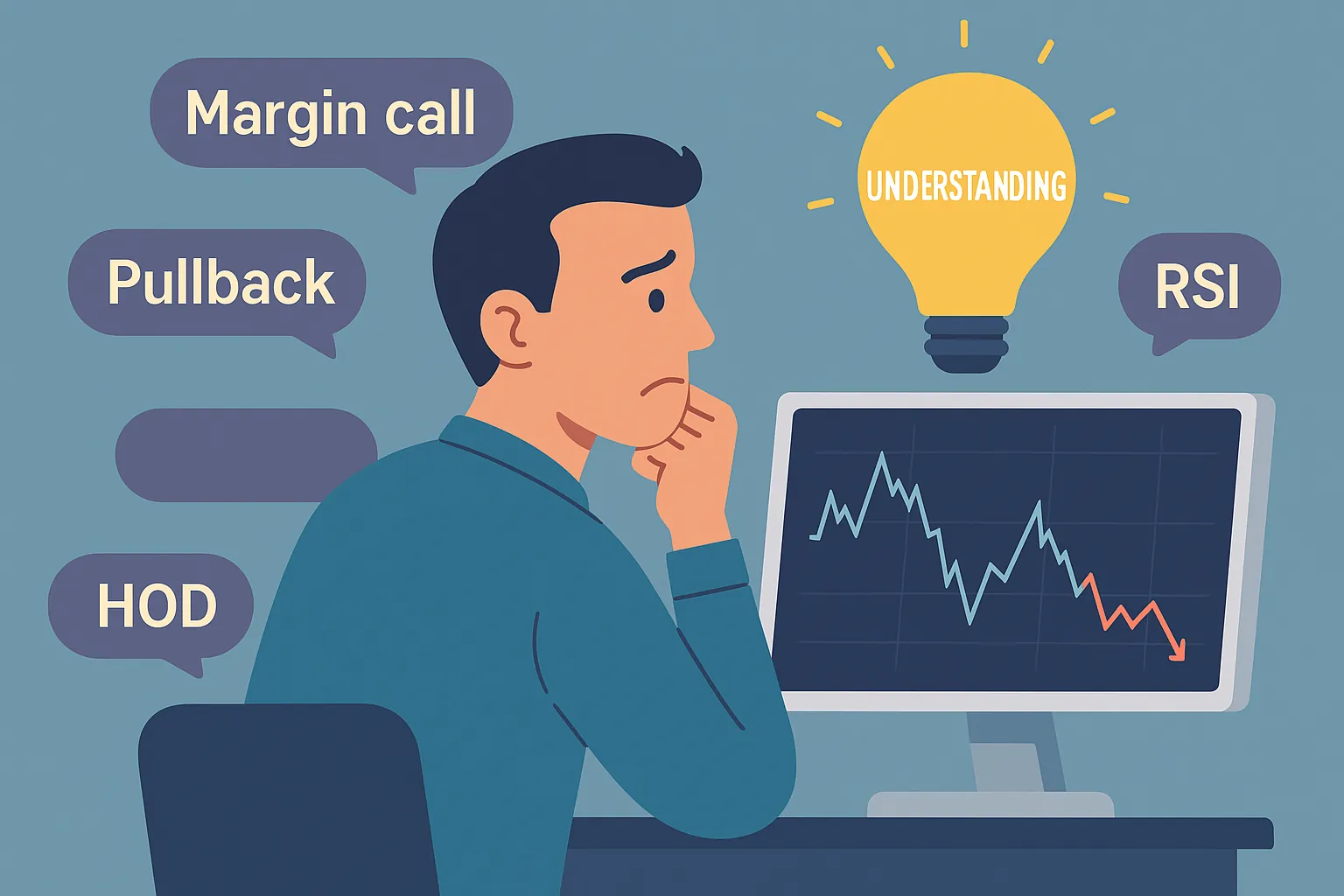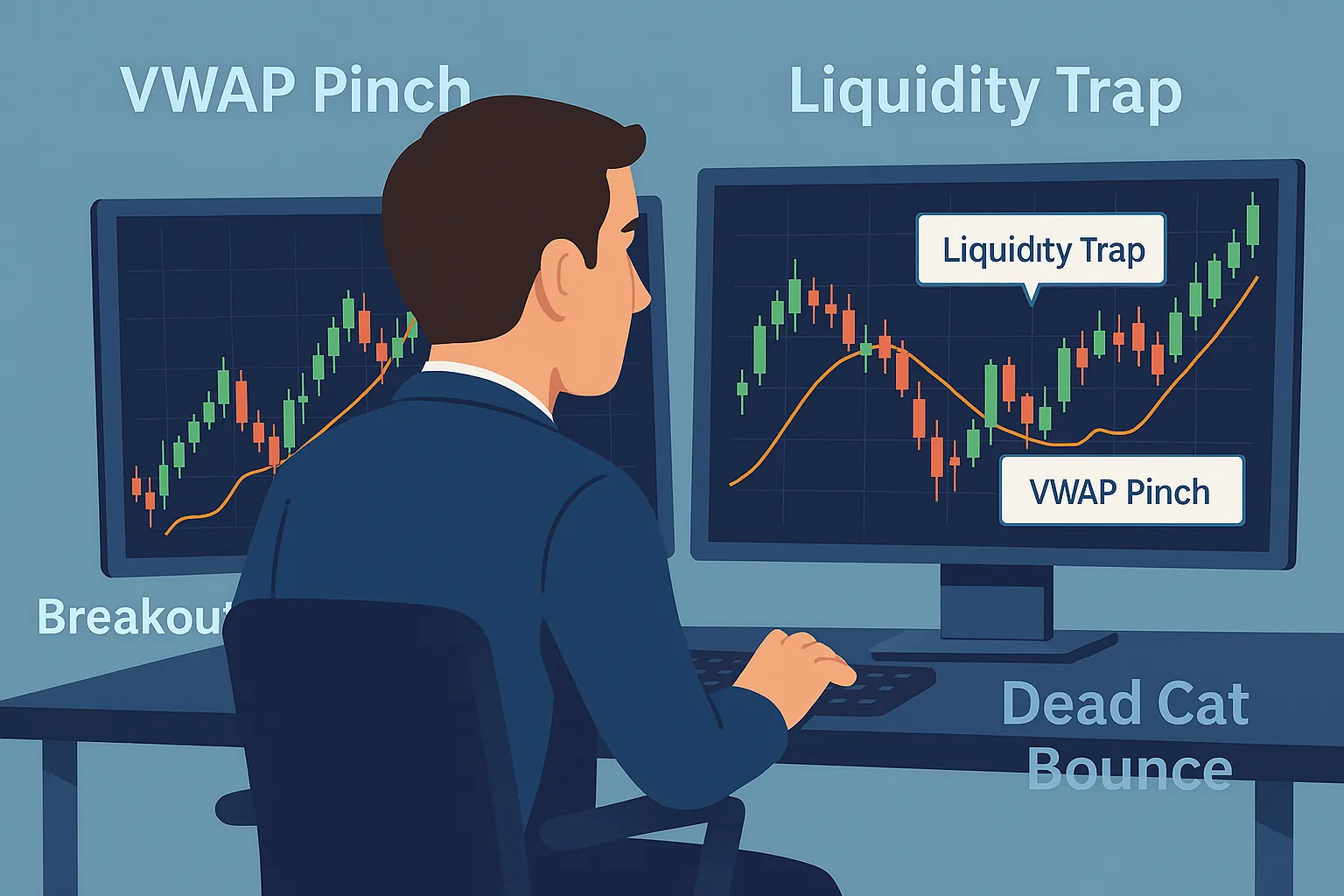📘 Investopedia Financial Dictionary
Browse hundreds of financial and stock market terms with examples, all curated by Investopedia editors.

Learn the most impactful trading terms, uncover real examples, explore expert tips, and boost your stock market confidence. Whether you’re a beginner or sharpening your edge, this guide is your ultimate lingo playbook.
Stock market lingo isn’t just fancy talk—it’s your gateway to trading clarity, speed, and confidence.
In a fast-paced financial world, being able to decode and use key stock market terms gives you a competitive edge.
When someone says “buy the dip,” “watch for resistance,” or “volume spike confirmed,” you want to understand instantly—not get left behind in the chat room.
💡 “In investing, what is comfortable is rarely profitable.” – Robert Arnott
Whether you’re following a day trade alert on Discord or watching a YouTube analyst break down chart patterns, you’ll hear shortcuts and abbreviations that make no sense—unless you know the language. This isn’t just slang. It’s shorthand for strategy.
Once you understand these signals, the market stops being a blur and starts speaking your language.
A member of a penny stock alert group saw this callout:
“$WXYZ watching VWAP reclaim for scalp”
Without knowing what “VWAP” or “scalp” means, a beginner would miss out or make the wrong move. But someone fluent would recognize:
And they’d execute accordingly, often with more precision and less hesitation.
Trading is social—even digital trading. If you walk into a chatroom full of active traders and speak like a tourist, you’ll be ignored. But if you say:
“Looking for a break above HOD with momentum confirmation”
—you’ll sound like you belong. This helps with getting feedback, learning from others, and being taken seriously.
🎤 “Language is the front-end of mindset. Once you speak the language, you think like a trader.”
— Erica Lang, CFA & Trading Psychology Coach
Fluency in stock market language isn’t optional—it’s a competitive advantage.
From executing a breakout strategy to understanding a reversal signal, every trading decision starts with language. The better your grasp, the faster and more accurate your trades become.
🎤 “Financial literacy starts with language. Once you understand the terms, the market becomes a map instead of a maze.”
— Erica Lang, CFA
Imagine being in a live trade room when someone calls:
“$PLUG reclaiming VWAP. Looking for confirmation above yesterday’s high.”
If you pause to Google terms like “VWAP” or “confirmation,” you’ve likely missed the move. Language in trading acts as a filter for opportunity. The faster you decode, the better you execute.
Reddit user @TradeFumbler once saw “bull trap” in a Discord thread and thought it meant a signal to buy. He jumped in… and the stock tanked 15%. In reality, a “bull trap” is a false breakout designed to lure buyers before a reversal. A costly mistake.
💬 “Jargon is only dangerous when you fake it. Master it, and you gain respect.” — DayTraderMark, Twitter

Illustration: Trader surrounded by terms like “margin call,” “RSI,” and “pullback” — glowing word “Understanding” in the center.
Every serious trader starts by mastering the basics. These terms form the foundation of trading communication—used by YouTubers, pro traders, and Discord mods alike. You’ll see them in trade alerts, stock chart commentary, and financial news headlines.
On March 10th, $NVDA opened with a gap up after strong earnings. But the price began to reverse and moved back down to the prior close. This is called a gap fill—and traders who recognized the pattern shorted the stock at the peak, scoring 5–7% intraday gains.
Miss that term, and you might’ve bought the top instead.
💬 “The moment I learned what resistance meant, I stopped buying at the top.”
— Amanda Li, swing trader & mentor
The deeper you go into trading, the more cryptic the language becomes. In fast-paced Discord rooms and Twitter threads, advanced traders use a set of shorthand buzzwords that pack strategy, timing, and intent into just one or two syllables.
Let’s break down some of the most powerful—and misunderstood—terms that separate amateurs from pros.
During the GameStop ($GME) short squeeze, traders who didn’t understand “FOMO” (Fear Of Missing Out) rushed into the stock after the initial spike. Buzzwords like “diamond hands” and “to the moon” were symbolic—but also costly for many.
Those who recognized the behavior as a pump-and-dump cycle with mass FOMO signals were able to exit near the top while others became long-term bagholders.

Image: A stylized chart image with terms like “Bagholder,” “Pump,” and “Momentum” floating like neon signs. One word—“Catalyst”—is spotlighted.
💬 “Buzzwords don’t just describe trades. They reveal mindset.”
— Mike Hofer, veteran day trader
Stock market language can empower you—or trick you. Unfortunately, the same buzzwords and technical terms that real traders use are often weaponized by scammers, fake gurus, and pump-and-dump promoters. Knowing the difference could save you thousands.
Be wary of overly promotional language that combines confidence with urgency. These phrases are common in email spam, Reddit threads, and Telegram groups trying to drive volume into low-float stocks:
In 2022, a penny stock pump group on Telegram promoted a biotech company as a guaranteed “gap up monster.” Within 48 hours, the stock fell 70%. Dozens of traders were left holding the bag.
The clues? Overuse of terms like “sure bet,” “insider leak,” and “life-changing move.” The lingo was meant to impress—not to inform.
🔐 “If a trader can’t explain it simply, they probably shouldn’t be trading it.”
— Warren Buffett
Once you’ve mastered the basics, it’s time to step into the language of elite traders. These terms go beyond standard definitions—they carry signals, timing strategies, and edge when used correctly.
Hedge funds, algorithmic traders, and veteran pros use them not just to describe trades, but to communicate silent rules of the market.
Pro traders spotted a “VWAP pinch” on $TSLA in late June. The price hugged VWAP with decreasing volume. Minutes later, a volume spike confirmed breakout and it ran 5% in 20 minutes. Those unfamiliar with the term missed the signal entirely.

Caption: Analyze like a pro — real strategies start with mastering real lingo.
Description: This digital landscape illustration features a focused trader at a dual-monitor workstation. His screens display technical candlestick charts with highlighted terms such as “VWAP Pinch,” “Liquidity Trap,” and “Dead Cat Bounce,” capturing the mindset and environment of experienced market participants.
💬 “Use the right lingo, and people assume you know your edge.”
— Larry Benedict, hedge fund manager
Now that you’ve decoded the lingo, the next step is practice. Whether you’re reading stock alerts, watching charts, or joining trading chat rooms, lingo allows you to move faster, speak confidently, and understand strategy on the fly.
Q: What if I don’t understand every term?
A: You’re not alone. Keep a glossary and revisit this guide. Focus on mastering terms you encounter most.
Q: How can I practice using trading terms?
A: Join communities like Swing Trading Chat Room or follow stock YouTubers. Write summaries of trades using lingo.
Q: Where do pros learn this stuff?
A: Most learn from experience, books, and live markets. Start with resources like Best Day Trading Books to fast-track your learning.
Browse over 5,000 terms with examples and definitions for every trading level.
Official regulatory insights to understand the basics and protect yourself as an investor.
Simple, actionable tutorials for stock trading beginners with examples and lingo tips.
Government-backed tools to help you invest wisely and recognize red flags.
💬 “Know the words, and you’ll start to see the patterns. Master the patterns, and the profits follow.”
— Sofia Ramos, Institutional Trader
Boost your vocabulary and deepen your investing knowledge with these trusted educational platforms:
Browse hundreds of financial and stock market terms with examples, all curated by Investopedia editors.
Official regulatory tips on investing basics, avoiding fraud, and understanding financial lingo for beginners.
Clear, beginner-friendly guide explaining essential market terminology and actionable tips to start trading.
The U.S. Securities and Exchange Commission’s official education portal for beginner investors and stock market terminology.